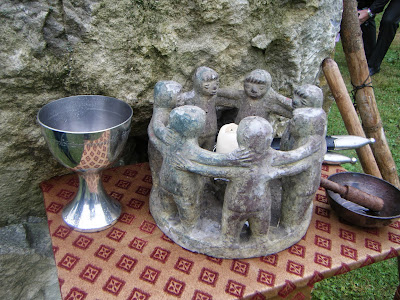A few weeks ago I posted about a wedding that we were invited to at the little Norman church in the lost village of Dode. After the civil ceremony in the church the now married couple took part in a pagan celebration called a Handfasting. I had never heard of this ritual before but Mrs C who reads a lot of Mills and Boon romance novels turned out to be a bit of an expert on the subject. Apparently handfasting goes back to Celtic times before the Romans paid us a visit and slaughtered all the Druids. The tradition carried on however and was still held as being a lawful form of marriage in Scotland until 1939.
Originally a handfasting was held to bind the couple together for the period of one year and one day as a kind of engagement or trial marriage to see if they could get along together. After this time had elapsed they would either decide to call it a day and go their separate ways or return to the sacred site to be handfasted together for life. This period of a year and a day appears to be symbolic in British law as it is also recognised in cases of murder. If the victim is assaulted and dies within this time then the assailant can be charged with their murder (I'm sure that there is no connection here).
The hand fasting ceremony is usually held out side preferably at a place of great religious significance to the Celts such as a sacred grove of trees or a stone circle. There is a stone circle at Dode which looks similar to ancient ones but is in fact only a few years old. However the stones were carefully selected from a local quarry, each was given a mystical name and the circle was laid down and blessed in a pagan ritual. Although the stones look shiny and new at the moment, after a few more years of weathering they will look as though they have been part of the landscape since the iron age (this should cause some confusion to archaeologists in the future).
Prior to the commencement of the celebration all the wedding guests formed a large circle around the Bride and Groom within the confines of the stones. A circle is a very significant symbol in the ceremony as it represents eternity, a sign that life, love and happiness have no beginning and no end. Two men from the congregation were chosen to protect the circle, in ancient times they would have probably been warriors but our chosen ones looked more like civil servants or computer geeks (Luckily our circle wasn't under any kind of threat). They were both given ceremonial daggers and patrolled around the circle opposite each other keeping all within safe throughout the handfasting.
The ceremony then began with the priest calling on the guardians of the four Cardinal points of the compass representing the four elements, to bless the couple and congregation starting with the East, as this is the direction from which the sun rises. The four elements are East (Fire), South (Air), West (Water) and North (Earth). The couple then clasped hands and the priest asked them a series of questions, as they answered each one he looped a cord around their hands eventually tying it off in a knot. They then shared a drink from a pewter goblet sealing their handfasting.
This particular ceremony ended with the couple jumping over a broom stick which symbolised them sweeping away the past and starting their married life together. If they wished they could have jumped across a sword as well as the broom stick. The sword represents the masculine protector and the broom stick the feminine home maker. Apparently there are several variations on the actual words used in the handfasting ceremony and the one that I witnessed was originally used in Victorian times. It was a really cool thing to witness and as it predates christianity I felt that this ceremony probably holds more significance to many people than the civil ceremony. It was more interesting that is for certain. I wonder if we will be invited back after a year and a day!





No comments:
Post a Comment